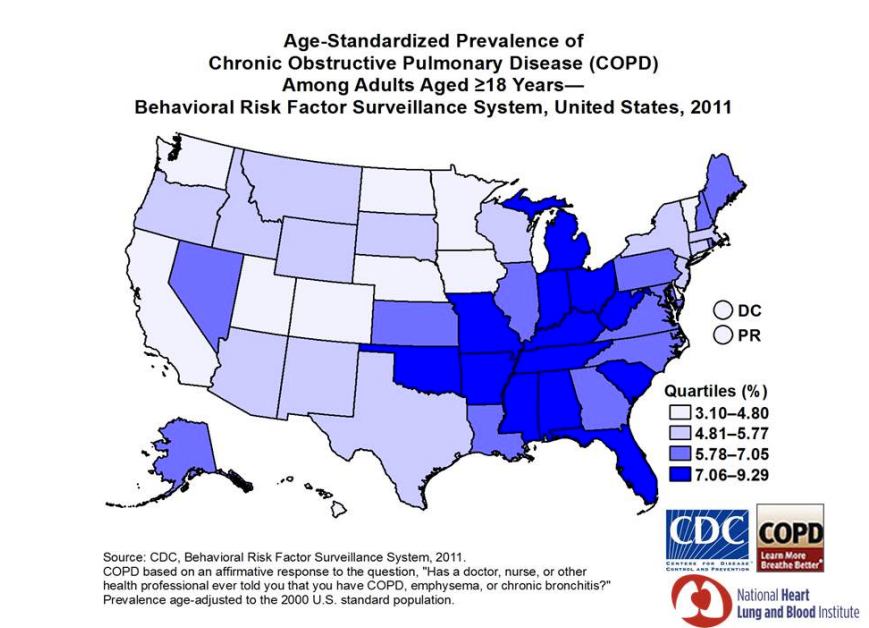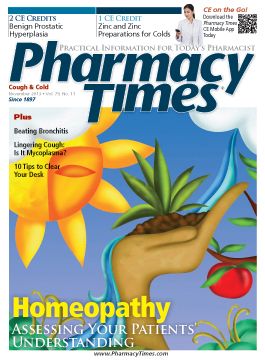Publication
Article
Pharmacy Times
Chronic Obstructive Pulmonary Disease: Seven Specifics to Remember
Author(s):
These 7 points can help guide patient counseling sessions on COPD.
These 7 points can help guide patient counseling sessions on COPD.
Pharmacists know that chronic obstructive pulmonary disease (COPD)—lung disease that restricts airflow and impairs breathing—is chronic and irreversible. However, pharmacists may need a brush-up on the basics—after all, COPD is easily confused with other lung diseases. COPD patients typically have chronic bronchitis and emphysema symptoms, but the classic triad also includes asthma. The approximately 14.8 million Americans diagnosed with COPD are more prone to other respiratory diseases, such as pneumonia or the flu. Experts think that an additional 10 to 12 million cases persist undiagnosed. Experts are also concerned because death rates for COPD are stagnating rather than declining—it’s now the third-leading cause of death in the United States.1 Pharmacists in certain contingent states, mostly in the east central United States, see more COPD cases than others (see figure below). Statistics aside, what else do we need to know? Here are 7 specifics that can direct your attention to interventions that work and can guide your counseling sessions.
1. Smoking cessation—and the earlier the better—is the sole intervention shown to decrease disease progression. With this in mind, antismoking campaigns should especially target young people. Smoking cessation before 40 years of age prevents 90% of smoking-associated mortality. For women, stopping before 30 years of age prevents more than 97% of excess mortality.2,3 Enough said about that!
2. Vaccination is critical. All pharmacists need to promote annual immunizations with influenza vaccine and pneumococcal vaccines. Annual flu shots are standard of care. The Centers for Disease Control and Prevention (CDC) 2013 immunization schedules recommend that high-risk adults—including COPD patients—receive the 13-valent pneumococcal conjugate vaccine (PCV13). The CDC’s Advisory Committee on Immunization Practices (ACIP) recommends the 23-valent pneumococcal polysaccharide vaccine (PPSV23) for all adults older than 65 years and for those younger than 65 years who are at high risk for pneumococcal disease or complications from pneumococcal disease. ACIP recommends that at-risk patients receive both PCV13 and PPSV23. Immunizers should administer PCV13 first and follow up with PPSV23 approximately 2 months later. If a patient has received PPSV23 but not PCV13, immunizers should wait 12 months before administering PCV13.4 Immunizing COPD patients in the pharmacy creates an opportunity to chat about the patient’s medications, control of the disease, and concerns.3,4

Move your cursor over the image to enlarge it.
3. Today’s drug therapies (Table 1) cannot prevent disease progression.5,6 There’s no positive spin here—glucocorticoids do not decrease disease progression significantly or prevent early mortality.6,7 It’s important to stress this with patients and encourage them to make lifestyle changes—especially smoking cessation—that will slow or stop disease progression.3
Table 1: Agents Used in COPD Treatment
Short-acting beta2-agonist bronchodilators
Albuterol
Levalbuterol
Metaproterenol
Pirbuterol
Long-acting beta2-agonist bronchodilators
Arformoterol
Formoterol
Indacaterol
Salmeterol
Vilanterol
Respiratory anticholinergics
Aclidinium
Ipratropium
Tiotropium
Xanthine derivatives
Theophylline
Phosphodiesterase-4 inhibitors
Roflumilast
Inhaled corticosteroids
Budesonide
Fluticasone
Oral corticosteroids
Prednisone
Combinations
Beta2 agonist/anticholinergic
Beta2 agonist/corticosteroid
Adapted from reference 8.
4. Inhalers are the COPD patient’s constant companion. Common treatments for COPD include inhalers that deliver either a bronchodilator or an inhaled corticosteroid. Combination products are also popular. Inhalers deliver medication directly to the lungs and avoid systemic exposure. They only manage COPD and don’t treat flares. Early in the disease, patients may need only a short-acting bronchodilator as needed for shortness of breath. As the disease progresses, a long-acting beta2-agonist may be needed in addition to the short-acting agent. At stage III or IV, prescribers often add an inhaled glucocorticoid.3 This cannot be overemphasized: pharmacists need to review inhaler technique with patients regularly.
5. Weight loss and exercise can improve cardiovascular health and lung function. Obesity severely impacts respiratory function, and weight loss can reduce shortness of breath.9 Exercise, too, can help patients improve their overall health status.3
6. Pulmonary hypertension is a common COPD complication. It is frequently mild to moderate, but can be severe, progressive, and ultimately deadly if right-sided heart failure exacerbates the patient’s ventilatory handicap. Oral anticoagulation and diuretics are often needed. Prescribers need to initiate specific therapies when pulmonary hypertension persists despite good COPD management and when pulmonary hypertension is “out of proportion” to the degree of airflow obstruction.10 The current selection of agents available to treat pulmonary hypertension includes the prostanoids (epoprostenol, iloprost, trepoprostenil), endothelin receptor antagonists (ambrisentan, bosentan), and phosphodiesterase type 5 inhibitors (sildenafil/Revatio [Pfizer, Inc] only, tadalafil/Adcirca [Eli Lilly and Company] only).11
7. Long-term oxygen therapy (LTOT) is not an as-needed proposition. The multicenter Nocturnal Oxygen Therapy Trial12 and the smaller Medical Research Council study13 identified LTOT as an intervention that improved survival in patients with COPD. LTOT approximately doubled survival at 19 months in patients who were adherent to oxygen. LTOT does not arrest disease progression, however. LTOT patients need to use oxygen at least 15 hours daily; note that its effects are not immediate. Most patients begin to benefit after a year or more of treatment.14,15 LTOT has benefits in addition to survival: pulmonary arterial hypertension stabilization,16 fewer cardiac arrhythmias and electrocardiographic findings suggestive of myocardial ischemia,17 increased exercise capacity,18-20 better neuropsychiatric function,21 improved health-related quality of life,20-22 and fewer exacerbations or hospitalizations.16,23 Pharmacists need to encourage patients to use their oxygen.
What’s Next?
Innovators constantly look for new treatments and potential targets for COPD, and pharmacists should monitor new drug approvals. In addition, stem cells could play a role in identifying new COPD treatments. Studies that use stem cells to grow new lung tissue are currently in the very early stages.
Anxiety and depression are serious concerns for COPD patients, so we need to be vigilant in addressing those concerns. COPD is a daily, wearing struggle for patients and their families, so pharmacists should be on the lookout for signs of physical and mental fatigue. A quick call to the patient’s physician may move the patient toward appropriate treatment.
Virginia Bartok is a retired pharmacist who comes out of retirement to write. Her primary practice was in indigent care, and she currently provides case management for several geriatric patients.
References
- COPD Ranked Third Leading Cause of Death in the US, CDC Reports. BusinessWire. www.businesswire.com/news/home/20101209006673/en/COPD-Ranked-Leading-Death-U.S.-CDC-Reports. Accessed October 15, 2013.
- Pirie K, Peto R, Reeves GK, Green J, Beral V. The 21st century hazards of smoking and benefits of stopping: a prospective study of one million women in the UK. Lancet. 2012;381:133-141.
- Gruffydd-Jones K. GOLD guidelines 2011: what are the implications for primary care? Prim Care Respir J. 2012;21:437-441.
- Wick JY. Pneumococcal vaccine recommendations updated. www.pharmacytimes.com/news/Pneumococcal-Vaccine-Recommendations-Updated. Accessed October 15, 2013.
- Decramer M, Janssens W, Miravitlles M. Chronic obstructive pulmonary disease. Lancet. 2012;379:1341-1351.
- Vestbo J, Hurd SS, Agusti AG, et al. Global strategy for the diagnosis, management and prevention of chronic obstructive pulmonary disease GOLD executive summary. Am J Respir Crit Care Med. 2013;187:347-365.
- Adcock IM, Caramori G, Kirkham PA. Strategies for improving the efficacy and therapeutic ratio of glucocorticoids. Curr Opin Pharmacol. 2012;12:246-251.
- Drug Facts and Comparisons. Facts & Comparisons [database online]. St. Louis, MO: Wolters Kluwer Health, Inc; March 2005. http://online.factsandcomparisons.com/login.aspx?url=/index.aspx&qs=. Accessed October 15, 2013.
- Dreher M, Kabitz HJ. Impact of obesity on exercise performance and pulmonary rehabilitation. Respirology. 2012;17:899-907.
- Minai OA, Chaouat A, Adnot S. Pulmonary hypertension in COPD: epidemiology, significance, and management: pulmonary vascular disease: the global perspective. Chest. 2010;137(6 suppl):39S-51S.
- Montani D, Günther S, Dorfmüller P, et al. Pulmonary arterial hypertension. Orphanet J Rare Dis. 2013;8:97.
- Nocturnal Oxygen Therapy Trial Group. Continuous or nocturnal oxygen therapy in hypoxemic chronic obstructive lung disease: a clinical trial. Nocturnal Oxygen Therapy Trial Group. Ann Intern Med. 1980;93:391-398.
- Long-term domiciliary oxygen therapy in chronic hypoxic cor pulmonale complicating chronic bronchitis and emphysema. Report of the Medical Research Council Working Party. Lancet. 1981;1:681-686.
- Dubois P, Jamart J, Machiels J, Smeets F, Lulling J. Prognosis of severely hypoxemic patients receiving long-term oxygen therapy. Chest. 1994;105:469-474.
- Zieliński J, Tobiasz M, Hawryłkiewicz I, Sliwiński P, Pałasiewicz G. Effects of long-term oxygen therapy on pulmonary hemodynamics in COPD patients: a 6-year prospective study. Chest. 1998;113:65-70.
- Ringbaek TJ, Viskum K, Lange P. Does long-term oxygen therapy reduce hospitalisation in hypoxaemic chronic obstructive pulmonary disease? Eur Respir J. 2002;20:38-42.
- Tirlapur VG, Mir MA. Nocturnal hypoxemia and associated electrocardiographic changes in patients with chronic obstructive airways disease. N Engl J Med. 1982;306:125-130.
- Davidson AC, Leach R, George RJ, Geddes DM. Supplemental oxygen and exercise ability in chronic obstructive airways disease. Thorax. 1988;43:965-971.
- Morrison DA, Stovall JR. Increased exercise capacity in hypoxemic patients after long-term oxygen therapy. Chest. 1992;102:542-550.
- Dean NC, Brown JK, Himelman RB, Doherty JJ, Gold WM, Stulbarg MS. Oxygen may improve dyspnea and endurance in patients with chronic obstructive pulmonary disease and only mild hypoxemia. Am Rev Respir Dis. 1992;146:941-945.
- Wedzicha JA. Effects of long-term oxygen therapy on neuropsychiatric function and quality of life. Respir Care. 2000;45:119-124.
- Eaton T, Lewis C, Young P, Kennedy Y, Garrett JE, Kolbe J. Long-term oxygen therapy improves health-related quality of life. Respir Med. 2004;98:285-293.
- Clini E, Vitacca M, Foglio K, Simoni P, Ambrosino N. Long-term home care programmes may reduce hospital admissions in COPD with chronic hypercapnia. Eur Respir J. 1996;9:1605-1610.

Newsletter
Stay informed on drug updates, treatment guidelines, and pharmacy practice trends—subscribe to Pharmacy Times for weekly clinical insights.






